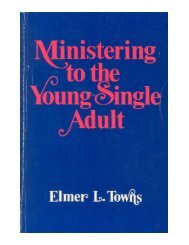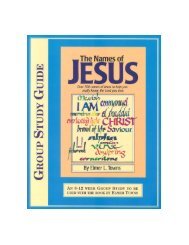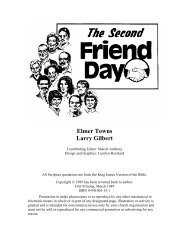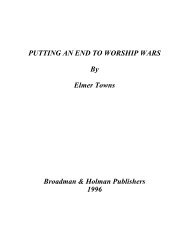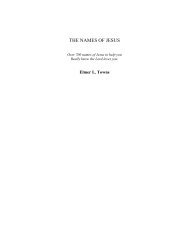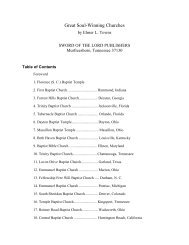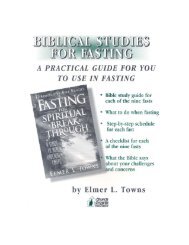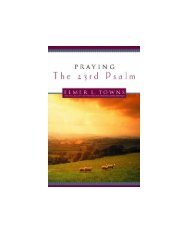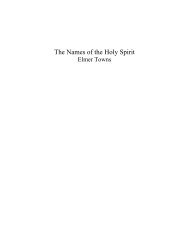A Journey Through The Old Testament - Elmer Towns
A Journey Through The Old Testament - Elmer Towns
A Journey Through The Old Testament - Elmer Towns
Create successful ePaper yourself
Turn your PDF publications into a flip-book with our unique Google optimized e-Paper software.
tree with a saw, cutting the prophet in half. Some commentators think Isaiah may be referred to<br />
in Hebrews 11:37 as an example of a man of faith who was “sawn in two.”<br />
But despite all the evil associated with the life of Manasseh, God never stopped loving<br />
him. “Now when he was in affliction, he implored the Lord his God, and humbled himself<br />
greatly before the God of his fathers, and prayed to Him; and He received his entreaty, heard his<br />
supplication, and brought him back to Jerusalem into his kingdom. <strong>The</strong>n Manasseh knew that the<br />
Lord was God” (2 Chron. 33:12-13).<br />
Manasseh had done much to destroy what his father had accomplished spiritually in the<br />
land, and in the final years of his reign, he did what he could to correct the error of his youth. He<br />
built up the defense of Jerusalem and other important cities in Judah and reorganized the national<br />
defense by appointing captains over specific cities. <strong>The</strong>n he began to purge the land of the many<br />
foreign gods he had earlier introduced to it. He repaired the altar of the Lord and decreed that<br />
only the Lord should be worshiped in the land. He was unsuccessful in closing all the high<br />
places, but those who worshiped there worshiped the Lord rather than idols.<br />
Because of the evil Manasseh had introduced into Judah, God raised up an enemy to<br />
discipline His people. Assyrian leaders fought against Manasseh and took him captive “with<br />
hooks” to Babylon. It was customary for the Assyrians to chain their prisoners together by<br />
placing rings or hooks through the jaw or nose of the prisoner. This appears to have been the fate<br />
of Manasseh.<br />
JOSIAH<br />
(2 Kings 22:1-23:30; 2 Chron. 34-35)<br />
(640-609 B.C.)<br />
Josiah is remembered as the last righteous king of Judah. After the two-year reign of<br />
Amon (642-640 B. C.), for thirty-one years Josiah sat on the throne of David and led the people<br />
back to God. <strong>The</strong>re were two significant events during his reign which led to the last great<br />
revival in Judah before the Captivity. <strong>The</strong> first of these occurred just eight years into his reign<br />
when he was sixteen years old.<br />
“For in the eighth year of his reign, while he was still young, he began to seek the God of<br />
his father David; and in the twelfth year he began to purge Judah and Jerusalem of the high<br />
places, the wooden images, the carved images, and the molded images” (2 Chron. 34:3). Little is<br />
known about the factors that led to the conversion of the teenage King Josiah, but several ideas<br />
have been suggested by various writers. He was no doubt aware of the consequence in the nation<br />
of the sins of his father and grandfather. He may have read of the conversion of his grandfather<br />
in the writings of Hozai (33:19) or been told of it by some member of the royal court who had<br />
been present at the time. Also, there is some indication Josiah may have been influenced<br />
spiritually by the Prophetess Huldah (34:26-28) and the Prophet Jeremiah (Jer. 22:16). As he<br />
began to realize the unique relationship his nation was to have with God, Josiah as king first<br />
made a personal commitment to God. <strong>The</strong>n, within four years of his own conversion, he began to<br />
exercise his responsibilities as king to cause his people to worship the Lord.<br />
It was actually as an indirect result of this initial renewal in Judah that the second key<br />
event promoting spiritual renewal in the land occurred. When the land had been purged of<br />
paganism, Josiah embarked on a second phase of reform, the restoration of the temple. It was<br />
while the temple was being repaired that “Hilkiah the priest found the Book of the Law of the<br />
Lord given by Moses” (2 Chron. 34:14). It is generally agreed this book was a copy of the Book<br />
of Deuteronomy, though some argue the book included the entire Pentateuch. Some think this



